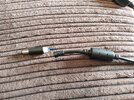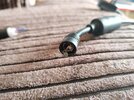TheJay
Member
Hey everyone,
I have a laptop charger cable, which has snapped after being flexed numerous times.
Can someone please tell me what the large plastic bit is and whether it's possible to cut the cable down slightly and add a new DC connector?
Thanks.
I have a laptop charger cable, which has snapped after being flexed numerous times.
Can someone please tell me what the large plastic bit is and whether it's possible to cut the cable down slightly and add a new DC connector?
Thanks.



